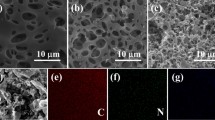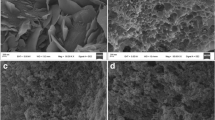Abstract
Porous activated carbon (AC) was successfully elaborated from olive stones and valued as an electrode material for electrical double-layer supercapacitors. The activated carbon surface was subsequently coated by silica to improve its physico-chemical and electrochemical properties. The treated activated carbon surface (AC-Si) exhibited a meso-microporous nature. From electrochemical investigations, an improvement of the capacitive behavior was demonstrated after the silica coating. When the bare activated carbon is used as electrode materials, the specific capacitance delivered by the assembled symmetric supercapacitor is 11 F g−1 at a current density of 0.5 A g−1 for an operating voltage of 0.6 V. However, the supercapacitor based on carbon–silica electrodes showed an obvious enhancement of the specific capacitance up to 141 F g−1 at 0.5 A g−1 and operated over a larger cell voltage of 1.25 V. For the AC-Si//AC-Si device, the exhibited specific energy is 30.6 Wh kg−1 and the specific power is 1661 W kg−1 at a current density of 0.5 A g−1. Therefore, the activated carbon derived from olive stones and coated by silica is a promising electrode material for supercapacitor devices.
Graphic abstract








Similar content being viewed by others
References
Simon P, Gogotsi Y (2008) Materials for electrochemical capacitors. Nat Mater 7:845–854
Zhang Y, Feng H, Wu X et al (2009) Progress of electrochemical capacitor electrode materials: a review. Int J Hydrogen Energy 34:4889–4899
Hao J, Zhong Y, Liao Y et al (2015) Face-to-face self-assembly graphene/MnO2 nanocomposites for supercapacitor applications using electrochemically exfoliated graphene. Electrochim Acta 167:412–420
Hall PJ, Mirzaeian M, Fletcher SI et al (2010) Energy storage in electrochemical capacitors: designing functional materials to improve performance. Energy Environ Sci 3:1238–1251
Male U, Uppugalla S, Srinivasan P (2015) Effect of reduced graphene oxide–silica composite in polyaniline: electrode material for high-performance supercapacitor. J Solid State Electrochem 19:3381–3388
Joshi S, Shrestha LK, Kamachi Y et al (2015) Synthesis and characterizations of nanoporous carbon derived from Lapsi (Choerospondias axillaris) seed: effect of carbonization conditions. Adv Powder Technol 26:894–900
Wang D, Geng Z, Li B, Zhang C (2015) High performance electrode materials for electric double-layer capacitors based on biomass-derived activated carbons. Electrochim Acta 173:377–384
Yang X, Kong L, Ma J et al (2019) Facile construction of hierarchically porous carbon nanofiber aerogel for high-performance supercapacitor. J Appl Electrochem 49:241–250
Zhang X, Zhang K, Li H et al (2018) Synthesis of porous graphitic carbon from biomass by one-step method and its role in the electrode for supercapacitor. J Appl Electrochem 48:415–426
Hannachi H, Msallem M, Ben Elhadj S et al (2007) Influence of the geographical locations on the agronomical and technological potentialities of the olive tree (Olea europaea L.) in Tunisia. C R Biologie 330:135–142
Sellami F, Jarboui R, Hachicha S et al (2008) Co-composting of oil exhausted olive-cake, poultry manure and industrial residues of agro-food activity for soil amendment. Bioresour Technol 99:1177–1188
Cagnon B, Py X, Guillot A et al (2009) Contributions of hemicellulose, cellulose and lignin to the mass and the porous properties of chars and steam activated carbons from various lignocellulosic precursors. Bioresour Technol 100:292–298
Abioye AM, Ani FN (2015) Recent development in the production of activated carbon electrodes from agricultural waste biomass for supercapacitors: a review. Renew Sustain Energy Rev 52:1282–1293
Yakout SM, Sharaf El-Deen G (2016) Characterization of activated carbon prepared by phosphoric acid activation of olive stones. Arab J Chem 9:S1155–S1162
Zhao Z, Hao S, Hao P et al (2015) Lignosulphonate-cellulose derived porous activated carbon for supercapacitor electrode. J Mater Chem A 3:15049–15056
Inagaki M, Kaneko K, Endo M et al (2003) Carbon alloys: novel concepts to develop carbon science and technology. Elsevier, Amsterdam, London
Ma F, Ding S, Ren H, Liu Y (2019) Sakura-based activated carbon preparation and its performance in supercapacitor applications. RSC Adv 9:2474–2483
Dujearic-Stephane K, Gupta M, Kumar A et al (2021) The effect of modifications of activated carbon materials on the capacitive performance: surface, microstructure, and wettability. J Compos Sci 5:66–90
Tripathi BP, Shahi VK (2011) Organic-inorganic nanocomposite polymer electrolyte membranes for fuel cell applications. Prog Polym Sci 36:945–979
Shao C, Kim HY, Gong J et al (2003) Fiber mats of poly(vinyl alcohol)/silica composite via electrospinning. Mater Lett 57:1579–1584
Alper JP, Vincent M, Carraro C et al (2012) Silicon carbide coated silicon nanowires as robust electrode material for aqueous micro-supercapacitor. Appl Phys Lett 100:163901–163904
Du X, Wang C, Li T, Chen M (2009) Studies on the performances of silica aerogel electrodes for the application of supercapacitor. Ionics (Kiel) 15:561–565
Leonard KC, Suyama WE, Anderson MA (2011) Improvement of electrochemical capacitor electrodes using SiO2 nanoparticles. Electrochim Acta 56:10137–10144
Huang H, Oike T, Watanabe F et al (2010) Development research on composite adsorbents applied in adsorption heat pump. Appl Therm Eng 30:1193–1198
Si M, Feng D, Qiu L et al (2013) Free-standing highly ordered mesoporous carbon–silica composite thin films. J Mater Chem A 1:13490–13495
Jaouadi M, Hbaieb S, Guedidi H et al (2017) Preparation and characterization of carbons from β-cyclodextrin dehydration and from olive pomace activation and their application for boron adsorption. J Saudi Chem Soc 21:822–829
Zemni S, Hajji M, Triki M et al (2018) Study of phosphogypsum transformation into calcium silicate and sodium sulfate and their physicochemical characterization. J Clean Prod 198:874–881
Strelko V, Malik DJ, Streat M (2002) Characterisation of the surface of oxidised carbon adsorbents. Carbon N Y 40:95–104
Béguin F, Presser V, Balducci A, Frackowiak E (2014) Carbons and electrolytes for advanced supercapacitors. Adv Mater 26:2219–2251
Wang K, Zhao N, Lei S et al (2015) Promising biomass-based activated carbons derived from willow catkins for high performance supercapacitors. Electrochim Acta 166:1–11
Kosmulski M (2002) The pH-dependent surface charging and the points of zero charge. J Colloid Interface Sci 253:77–87
Zawadzki J (1989) Infrared spectroscopy in surface chemistry of carbons. In: Thrower PA (ed) Chemistry and physics of carbon, vol 21. Marcel Dekker, New York, pp 147–386
Wang X (2011) Chemical and morphological characterization of mesoporous material supported copper oxide nanoparticles for potential application. J Porous Mater 18:623–630
Ciric-Marjanovic G, Dragičević L, Milojević M et al (2009) Synthesis and characterization of self-assembled polyaniline nanotubes/silica nanocomposites. J Phys Chem B 113:7116–7127
Rajagopal RR, Aravinda LS, Rajarao R et al (2016) Activated carbon derived from non-metallic printed circuit board waste for supercapacitor application. Electrochim Acta 211:488–498
Lu C, Su F, Hu S (2008) Surface modification of carbon nanotubes for enhancing BTEX adsorption from aqueous solutions. Appl Surf Sci 254:7035–7041
Rajarao R, Mansuri I, Dhunna R et al (2014) Study of structural evolution of chars during rapid pyrolysis of waste CDs at different temperatures. Fuel 134:17–25
Sheng W, Shi T, Sun B, et al (2013) Three dimensional metal film catalyst assisted etching of silicon. In: Technical proceedings of the 2013 NSTI nanotechnology conference and expo, NSTI-nanotech, vol 2. pp 427–430
Nakamizo M, Kammereck R, Walker PL (1974) Laser Raman studies on carbons. Carbon N Y 12:259–267
Chmiola J, Yushin G, Gogotsi Y et al (2006) Anomalous increase in carbon at pore sizes less than 1 nanometer. Science 313:1760–1763
Jaouadi M, Hamzaoui AH (2019) Boron adsorption onto activated carbon and amorphous carbon prepared from sucrose dehydration. Desalin Water Treat 149:150–156
Chong MY, Numan A, Liew CW et al (2018) Enhancing the performance of green solid-state electric double-layer capacitor incorporated with fumed silica nanoparticles. J Phys Chem Solids 117:194–203
Kim SY, Kim BH (2016) Silica decorated on porous activated carbon nanofiber composites for high-performance supercapacitors. J Power Sources 328:219–227
Elmouwahidi A, Zapata-Benabithe Z, Carrasco-Marín F et al (2012) Activated carbons from KOH-activation of argan (Argania spinosa) seed shells as supercapacitor electrodes. Bioresour Technol 111:185–190
Long C, Zhuang J, Xiao Y et al (2016) Nitrogen-doped porous carbon with an ultrahigh specific surface area for superior performance supercapacitors. J Power Sources 310:145–153
Sudhan N, Subramani K, Karnan M et al (2017) Biomass-derived activated porous carbon from rice straw for a high-energy symmetric supercapacitor in aqueous and nonaqueous electrolytes. Energy Fuels 31:977–985
Shen C, Li R, Yan L et al (2018) Applied surface science rational design of activated carbon nitride materials for symmetric supercapacitor applications. Appl Surf Sci 455:841–848
Wen Y, Qin T, Wang Z et al (2017) Self-supported binder-free carbon fibers/MnO2 electrodes derived from disposable bamboo chopsticks for high-performance supercapacitors. J Alloys Compd 699:126–135
Rawal S, Joshi B, Kumar Y (2018) Synthesis and characterization of activated carbon from the biomass of Saccharum bengalense for electrochemical supercapacitors. J Energy Storage 20:418–426
Wang B, Qiu J, Feng H et al (2016) KOH-activated nitrogen doped porous carbon nanowires with superior performance in supercapacitors. Electrochim Acta 190:229–239
Rajesh M, Manikandan R, Park S et al (2020) Pinecone biomass-derived activated carbon: the potential electrode material for the development of symmetric and asymmetric supercapacitors. Int J Energy Res 44:8591–8605
Ye Z, Wang F, Jia C et al (2018) Biomass-based O, N-codoped activated carbon aerogels with ultramicropores for supercapacitors. J Mater Sci 53:12374–12387
Pang J, Zhang W, Zhang J et al (2017) Facile and sustainable synthesis of sodium lignosulfonate derived hierarchical porous carbons for supercapacitors with high volumetric energy densities. Green Chem 19:3916–3926
Hu Z, Li S, Cheng P et al (2016) N, P-co-doped carbon nanowires prepared from bacterial cellulose for supercapacitor. J Mater Sci 51:2627–2633
Ahmed S, Ahmed A, Rafat M (2019) Investigation on activated carbon derived from biomass Butnea monosperma and its application as a high performance supercapacitor electrode. J Energy Storage 26:100988–100997
Mourad E, Coustan L, Lannelongue P et al (2017) Biredox ionic liquids with solid-like redox density in the liquid state for high-energy supercapacitors. Nat Mater 16:446–454
Lannelongue P, Le Vot S, Fontaine O et al (2018) Investigation of Ba0.5Sr0.5CoxFe1−xO3−δ as a pseudocapacitive electrode material with high volumetric capacitance. Electrochim Acta 271:677–684
Acknowledgements
This research was supported by The Tunisian Ministry of Higher Education and Scientific Research. The authors thank Mr. Mounir Hajji for chemical resources.
Author information
Authors and Affiliations
Corresponding author
Additional information
Publisher's Note
Springer Nature remains neutral with regard to jurisdictional claims in published maps and institutional affiliations.
Supplementary Information
Below is the link to the electronic supplementary material.
Rights and permissions
About this article
Cite this article
Jaouadi, M., Marzouki, M., Hamzaoui, A.H. et al. Enhanced electrochemical performance of olive stones-derived activated carbon by silica coating for supercapacitor applications. J Appl Electrochem 52, 125–137 (2022). https://doi.org/10.1007/s10800-021-01623-4
Received:
Accepted:
Published:
Issue Date:
DOI: https://doi.org/10.1007/s10800-021-01623-4




